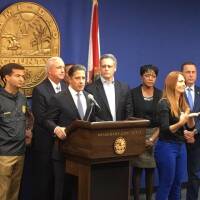On this Thursday, January 20, edition of Sundial:
How the pandemic has changed college
More than 1 million fewer students are enrolled in college now than before the pandemic began.
WLRN is committed to providing the trusted news and local reporting you rely on. Please keep WLRN strong with your support today. Donate now. Thank you.
U.S. colleges and universities saw a drop of nearly 500,000 undergraduate students in the fall of 2021, according to an NPR report. That continues a historic decline that began the previous fall.
What does this national trend for college enrollment actually look like across South Florida?
The panel included:
- Dr. Frank Wood is the vice president of advancement at the College of the Florida Keys.
- Maura Flaschner is the executive director of undergraduate admission at Florida Atlantic University.
- John Haller is the vice president of enrollment management at the University of Miami.
- Janice Stubbs is Broward College's vice president of student services.
This excerpt of the conversation has been edited for clarity.
WOOD: Our enrollment at the College of the Florida Keys has been on a trajectory of growth, probably ever since Hurricane Irma. Some of the things that we do are just really so specific to being here that it really created still-continued demand here.
One of our biggest challenges here is for the students that don't live here to find a place to live and go to school here. You don't want to necessarily learn how to dive online, and I don't recommend it [online]. So we found still the demand to be here for those things that that that we do excellently well here because of our geography and our great faculty here with the expertise that they have in those areas.
Another thing that happened this year that actually is a driver of our 8 percent growth this year is we opened a new center in Key Largo. Now, when you think about the service area of our college, we serve the entire Florida Keys so you've got 126 miles by about, you know, a quarter of a mile wide or less, depending on if you're on a bridge. And it's a long way to serve. And we had been having relationships with high schools in different areas in the Middle and Upper Keys, but we were able to open a 40,000-square-foot new facility right on the highway as you get off the 18 Mile Stretch this past August, and that also has been a great driver for our growth this year.
FLASCHNER: I think interest in enrolling is very strong. We're seeing strong application numbers for both first-year and transfer students. I think that our students and families when it comes time to commit, we are seeing some stability in our enrollment. However, our Pell Grant students, our students that are financially the neediest are making some decisions about employment, since we have an incredibly strong and diverse economy here in South Florida. Some of our neediest students are choosing workforce right now versus enrollment. But we have seen a very steady trend of enrollment very stable here at Florida Atlantic.
HALLER: The University of Miami right now is in a place where interest in the university is at an all-time high. And for example, this past year for incoming class fall 2022, the university received in excess of 49,000 applications, which is up 16 percent from the prior year, which was an all-time high the prior year as well. So that phenomenon that's been experienced nationally is not something that the university's experienced.
We have a curriculum that is one that allows them [students] to find interdisciplinary programs that allow them to marry their interests, which I think is really unique in higher ed. I guess the other piece I'd add is [the university] is an incredibly ethnically and socioeconomically diverse institution, which I think is really attractive to people. And I think there's a vibrancy associated with Miami in general that I think attracts a lot of a number of applicants.
STUBBS: Like many community colleges across the country, we're seeing a decline, particularly with our Pell [Grant] eligible students. We're seeing that they have the highest decline. However, we're also seeing growth, though in our online modality. We're growing in the online space. And we've also added what we're calling “B.C. online live” in which faculty and students come together at the designated time, day in time and through the virtual environment to host and to facilitate classes. And that's a growing interest for our students where it's not fully online, but they have the instructor present. And so we're really expanding in that area and making sure that we're offering that modality not just to fully online, but that modality for the courses that are most in-demand at the college.

WLRN’s new education reporter
There’s not a dull moment in education news nowadays.
Two South Florida school districts, Miami-Dade and Broward, are looking for new leaders. There’s COVID, politics — and as we heard from teachers on Sundial earlier this week, student behavior and teacher shortages are taking a toll on children’s education.
Higher education has also been changed by the pandemic. Virtual learning is pushing some to further question the cost of college. Plus, nationally, enrollment is low at universities.
We meet WLRN’s new education reporter Kate Payne. Read more of her reporting here.



